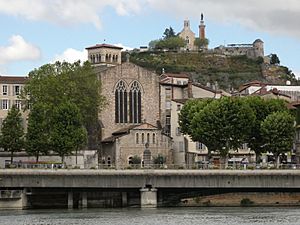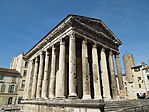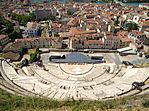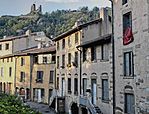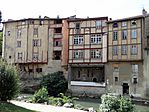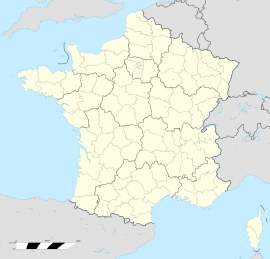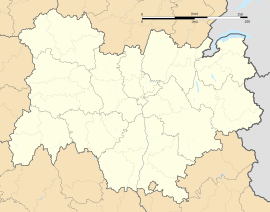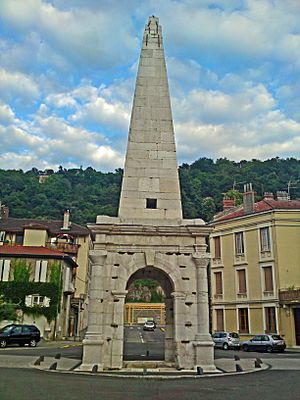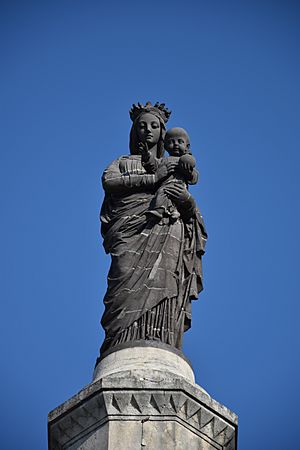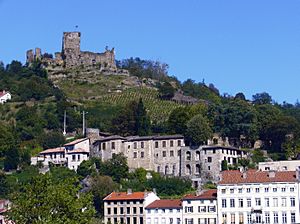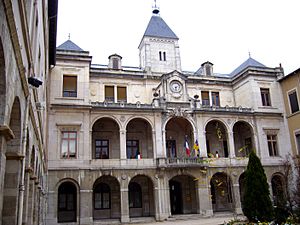Vienne, Isère facts for kids
Quick facts for kids
Vienne
Vièna (Arpitan)
|
||
|---|---|---|
|
Subprefecture
|
||
|
From left to right, top to bottom: partial view of the city and the Rhône river from Saint-Romain-en-Gal with the Pipet sanctuary atop the hill; the Gallo-Roman temple of Augustus and Livia; the Gallo-Roman Theatre and the city from Pipet hill; the Saint-Maurice Cathedral; the Obelisk from the Gallo-Roman circus; the Château de la Bastie atop its hill; the Petite rue de la Cocarde; the Gère riverbanks with its traditional architecture.
|
||
|
||
| Motto(s):
Vienna Civitas Sancta
"Vienne Saint City" (prior to 1887) Vienna Urbs Senatoria "Vienne Senatorial City" (since 1887) |
||
| Country | France | |
| Region | Auvergne-Rhône-Alpes | |
| Department | Isère | |
| Arrondissement | Vienne | |
| Canton | Vienne-1 and 2 | |
| Intercommunality | CA Vienne Condrieu | |
| Area
1
|
22.65 km2 (8.75 sq mi) | |
| Demonym(s) | Viennois | |
| Time zone | UTC+01:00 (CET) | |
| • Summer (DST) | UTC+02:00 (CEST) | |
| INSEE/Postal code |
38544 /38200
|
|
| Elevation | 140–404 m (459–1,325 ft) (avg. 169 m or 554 ft) |
|
| 1 French Land Register data, which excludes lakes, ponds, glaciers > 1 km2 (0.386 sq mi or 247 acres) and river estuaries. | ||
Vienne is a historic town in southeastern France. It is located about 35 kilometers (22 miles) south of Lyon. The town sits where the Gère river meets the mighty Rhône river.
Vienne is the fourth largest town in the Isère department. It is also a "subprefecture," which means it's an important administrative center for the area.
Long ago, Vienne was a major city in the Roman Empire. The Romans called it Vienna. Before the Romans arrived, it was the capital of the Allobroges, a Gallic tribe.
In 47 BC, under Julius Caesar, Vienne became a Roman colony. Its location along the Rhône river made it a key trading and communication hub. The Roman Emperor Augustus even sent Herod Archelaus, son of Herod the Great, to live in exile here in 6 AD.
Many Roman buildings still stand in Vienne today. It was also an early center for Christianity in Gaul. A famous meeting called the Council of Vienne took place here in 1311. During this council, Pope Clement V ended the order of the Knights Templar.
In the Middle Ages, Vienne was part of the Kingdom of Provence. This kingdom was linked to the Holy Roman Empire. The land on the other side of the Rhône river was French territory. This made Vienne a very important strategic location.
Today, Vienne is a busy center for business and industry. It is well-known for its Saturday market. Many Roman sites, like a temple, a circus pyramid, and a theater, attract visitors. The theater hosts the yearly Jazz à Vienne festival. Museums and old churches also make tourism a big part of Vienne's economy.
Contents
History of Vienne
Vienne in Roman Times
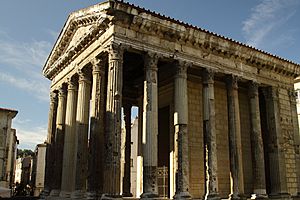
The town of Vienne was once a fortified settlement, or oppidum, of the Allobroges tribe. Around 47 BC, it became a Roman colony under Julius Caesar. However, the Allobroges briefly drove out the Romans. These Roman exiles then went on to found the city of Lugdunum, which is now Lyon.
During the early Roman Empire, Vienna (as the Romans called it) regained its special status as a Roman colony. It's important not to confuse it with modern-day Vienna, which was known as Vindobona back then.
In 260 AD, a man named Postumus was declared Emperor in Vienne. He led a short-lived empire known as the Gallic Empire. Later, Vienne became a capital city for a Roman province called the Dioecesis Viennensis.
On the banks of the Gère river, you can still see parts of the old Roman city walls. On Mont Pipet, east of the town, are the remains of a Roman theater. A medieval castle there was built on top of Roman foundations. You can also find traces of ancient aqueducts and Roman roads.
Two major Roman monuments still stand in Vienne. One is the Temple of Augustus and Livia. This temple was built by Emperor Claudius. It survived because it was turned into a church early on. Later, during the French Revolution, it was used for a special event called the Festival of Reason.
The other monument is the Plan de l'Aiguille. This is a pyramid-shaped structure that sits on top of an archway. It was part of the Roman circus, where chariot races were held. Old stories from the 13th century say that Pontius Pilate died in Vienne. Later legends claimed the pyramid was his tomb, or the tomb of Herod Archelaus.
In 1945, parts of a temple dedicated to the goddess Cybele were found. This happened when a new hospital was being built. More digging in 1965 helped experts understand the temple's layout. They learned it was built in the first century AD.
Christian History in Vienne
Vienne was an important early center for Christian leaders, called bishops. The first bishop is said to have been Crescens, a follower of Paul the Apostle. Christians were present here by 177 AD. The churches of Vienne and Lyon even wrote a letter to churches in Asia and Phrygia.
The first bishop we know for sure was Verus of Vienne. He attended a meeting of church leaders in Arles in 314 AD. Around 450 AD, Vienne's bishops became archbishops. Some of them, like Mamertus and the poet Avitus of Vienne, were very important.
Vienne's archbishops and those from Lyon often argued over who had the title of "Primate of All the Gauls." This title meant being the most important church leader in Gaul. They based their claims on how old their cities and bishoprics were. Vienne's archbishopric was closed in 1790 during the French Revolution. It officially ended in 1801.
Vienne in the Middle Ages
Vienne was attacked many times during the Migration period. It was taken by the Kingdom of the Burgundians in 438 AD. The Romans took it back, but then the Burgundians held it again from 461. In 534, the Franks captured Vienne. The town was later attacked by the Lombards in 558 and by the Moors in 737.
In 843, the Frankish kingdom was divided into three parts. Vienne became part of Middle Francia. Later, in 879, a count named Boso of Provence declared himself king of Provence. Vienne became the capital of this kingdom.
The archbishops of Vienne became the true rulers of the city. Their power was recognized many times. However, they had rivals in the counts of Albon. In 1349, the ruling Dauphin sold his rights to the Dauphiné region to France. But Vienne was not included in this sale. The archbishops finally gave up their control of the land to France in 1449.
The Council of Vienne was a very important meeting of the Roman Catholic Church. It took place in Vienne between 1311 and 1312. The main decision made there was to stop supporting the Knights Templar. This was pushed by Philip IV, the King of France.
Vienne Becomes French
Vienne officially became part of France in 1449. In 1562, Protestants attacked and looted Vienne. The town was held by a group called the Ligue from 1590 to 1595. Then, it was taken for King Henri IV. The city's defenses were torn down between 1589 and 1636.
Industrial Growth
Train stations were built in Vienne in 1855 and in Estressin in 1875. These stations helped transport goods for the textile and metal industries. These industries had already started using the water power from the Gère river valley in earlier centuries.
Population Changes
| Historical population | |||||||||||||||||||||||||||||||||||||||||||||||||||||||||||||||||||||||||||||||||||||||||||||||||||||||||||||||||||
|---|---|---|---|---|---|---|---|---|---|---|---|---|---|---|---|---|---|---|---|---|---|---|---|---|---|---|---|---|---|---|---|---|---|---|---|---|---|---|---|---|---|---|---|---|---|---|---|---|---|---|---|---|---|---|---|---|---|---|---|---|---|---|---|---|---|---|---|---|---|---|---|---|---|---|---|---|---|---|---|---|---|---|---|---|---|---|---|---|---|---|---|---|---|---|---|---|---|---|---|---|---|---|---|---|---|---|---|---|---|---|---|---|---|---|---|
|
|
||||||||||||||||||||||||||||||||||||||||||||||||||||||||||||||||||||||||||||||||||||||||||||||||||||||||||||||||||
| Source: EHESS and INSEE (1968-2017) | |||||||||||||||||||||||||||||||||||||||||||||||||||||||||||||||||||||||||||||||||||||||||||||||||||||||||||||||||||
Important Buildings and Monuments
Vienne has two amazing Roman ruins. These are the temple of Augustus and Livia, and the Plan de l'Aiguille (or Pyramide). The pyramid is a unique structure from the city's Roman circus.
The old Romanesque church of Saint Peter was once part of a Benedictine monastery. It was rebuilt in the 9th century. This church is one of France's oldest Christian buildings, dating back to the 5th century. It has a large, well-built main hall, a Romanesque tower, and a sculpted entrance. Today, it is a museum that displays ancient stone carvings.
The Gothic former cathedral of St Maurice was built between 1052 and 1533. It is a large church with three main sections and a rounded end, but no side wings. It is 96 meters (315 feet) long, 36 meters (118 feet) wide, and 27 meters (89 feet) high. The most impressive part is the front, which rises grandly from a terrace above the Rhône river. Its sculptures were badly damaged by Protestants in 1562 during the French Wars of Religion.
The Romanesque church of St André en Bas was another Benedictine monastery church. It became the chapel for early kings of Provence. It was rebuilt in 1152 in a later Romanesque style.
Images for kids
-
The SNCF Train Station of Vienne
-
Legend of the pyramid as Pontius Pilate's tomb
-
The banks of the river Rhône, in central Vienne
Famous People from Vienne
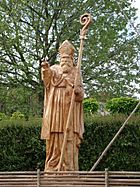
Many notable people have connections to Vienne:
- Herod Archelaus (23 BC – ca.18 AD), a ruler exiled here by Emperor Augustus.
- Pontius Pilate (according to legend), a Roman governor.
- Avitus of Vienne (450–ca.578), a poet, bishop, and saint.
- Boso of Provence (ca.841–887), a Carolingian king.
- Pope Callixtus II (1065–1124), who was Archbishop of Vienne before becoming Pope.
- Michael Servetus (1509–1553), a scholar.
- Nicolas Chorier (1612–1692), a lawyer, historian, and author.
- Jean-François Leriget de La Faye (1674–1731), a diplomat and poet.
- Jean-Baptiste-Charles Chabroud (1750–1816), a French lawyer and politician.
- Laurent Mourguet (1769–1884), a famous puppeteer.
- François Ponsard (1814–1867), a French playwright and poet.
- Louis Vialleton (1859-1929), a French zoologist.
- Fernand Point (1897–1955), a renowned chef.
- Hubert Sagnières (born 1955), a business executive.
Sister Cities
Vienne has "sister city" relationships with several towns around the world. This means they share cultural and educational ties.
- Albacete, Spain
- Esslingen am Neckar, Germany
- Greenwich, United States
- Goris, Armenia
- Neath Port Talbot, Wales, United Kingdom
- Piotrków Trybunalski, Poland
- Schiedam, Netherlands
- Udine, Italy
- Velenje, Slovenia
See also
 In Spanish: Vienne (Isère) para niños
In Spanish: Vienne (Isère) para niños


